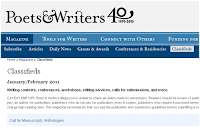 |
| Writer and Editor Anne Witkavitch |
This week we conclude our series on writing for anthologies with writer Anne Witkavitch, who compiled and edited Press Pause Moments: Essays About Life Transitions by Women Writers based on the Press Pause Project.
AA: What were the takeaways for you on this project?
AW: I learned so much about the process of taking a book from concept to publication. There was tremendous value to wearing the editor's hat, not only writing for the book but also for selecting, editing and sequencing other writers' works. For example, editing multiple voices was a bit more challenging than I anticipated. You have to pay even more attention to achieve style consistency from page to page. I tend to be a person who can see the vision and big picture, and then home in on the details to bring all the pieces together. That came in particularly handy for this project.
AA: What would you recommend to writers seeking publication in an anthology?
AW: First, follow the submission guidelines. If the word count maxes out at 1,500, don't submit something with 3,000 words. Choose to edit first, or don't submit at all. Second, be professional. For Press Pause Moments, the e-mail was the first interaction I had with most of the writers, and first impressions always count — even in cyberspace. Be personable, but to the point. Third, submit your best-quality work. Edit and proofread. This is a pet peeve of mine. I know how much time I invest in editing and revising. I can tell when someone has written something, checked it over, and then submitted the piece without any rework. Fourth — and perhaps most important — is to submit! If you write for you, and simply want to keep your work tucked away in a file folder, that's fine. But if you want to be published, anthologies are a great way to get your work out there and read.
 |
| Press Pause Moments is on Amazon |
AA: Is there anything you'd like to add?
AW: Writing is a tough gig. Sitting down and writing every day is hard. Sending out your work is hard. Getting rejected is hard. But you've got to keep at it. I am a big proponent of having a strategic plan to guide your writing ambition. In fact, I teach a workshop in Goal Setting for Writers based on the Press Pause principles. It's intended to get writers to articulate what they want to achieve and then figure out how to get it done with one-, two- and three-year goal components. Life is dynamic, and if you don't know what you're working for, you can easily get knocked off course. In fact, the Press Pause Moments anthology's life cycle paralleled some major challenges in my life: the crippling recession, my sister's death from cancer and a major health issue. If I hadn't had a strong vision and plan — and a lot of resilience and support — the book would never have happened.
Finally, every writer should wear the editor's hat on a project involving other writers' works. I have edited several books this year, including another anthology and a nonfiction book. There is no better way to continuously improve your own writing skills!
For more information, see Press Pause Moments or Amazon. Or visit Anne's page at Western Connecticut State University.




